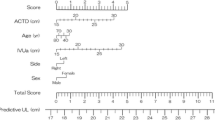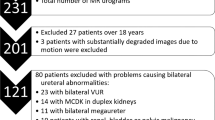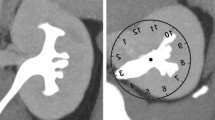Abstract
Ureteric length is the most important factor for determining the ideal length of a ureteric stent. In most of the literature, ureteric length is estimated according to a patient’s height. We investigated the reliability of a patient’s height as a measure of ureteric length. We measured the actual length of the ureteric trace (ALUT) and the linear distance (LD) from the ureterorenal junction to the ureterovesical junction by intravenous pyelography (IVP), using a 15 min view. A total of 203 patients (100 men, 103 women, 406 ureters) with normal findings were studied, and ALUT, LD and height were measured. The mean patient height was 164.3±8.3(SD) cm. Mean ALUTs of the right and left ureters were 23.4±1.9 cm and 24.4±2.0 cm, respectively, and the mean LDs of the right and left ureters were 22.1±1.9 cm and 22.9±2.0 cm, respectively. Height was significantly correlated with the ALUTs of both sides, but these were not linear (r2=0.024 right, 0.059 left). However, LD showed significant linear correlations with the ALUTs of both sides (r2=0.879 right, 0.884 left). Two formulas to estimate the ALUT from LD were suggested: right ALUT=0.94×right LD+2.6, left ALUT=0.96×left LD+2.4. Our results demonstrated that patient height does not provide a reliable estimate of ureteric length. LD by IVP is preferable to patient height when estimating the ureteric length.


Similar content being viewed by others
References
Laverson PL, Hankins GD, Quirk JG (1984) Ureteral obstruction during pregnancy. J Urol 131: 327
Lang EK, Lanasa JA, Garrett J, Stripling J, Palomar J (1979) The management of urinary fistulas and strictures with percutaneous ureteral stent catheters. J Urol 122: 736
LeRoy AJ, Williams HJJr, Segura JW, Patterson DE, Benson RCJr (1986) Indwelling ureteral stents: percutaneous management of complications. Radiology 158: 219
Ansong K, Khashu B, Lee WJ, Smith AD (1985) Prophylactic use of ureteral stent in iatrogenic injuries to the ureter. Urology 26: 45
Ball AJ, Gingell JC, Carter SS, Smith PJ (1983) The indwelling ureteric splint: the Bristol experience. Br J Urol 55: 622
Pryor JL, Jenkins AD (1990) Use of double-pigtail stents in extracorporeal shock wave lithotripsy. J Urol 143: 475
Saltzman B (1988) Ureteral stents: indications, variations, and complications. Urol Clin North Am 15: 481
Warren JW, Damron D, Tenney JH, Hoopes JM, Deforge B, Muncie HLJr (1987) Fever, bacteremia, and death as complications of bacteriuria in women with long term urethral catheters. J Infect Dis 155: 1151
Warren JW, Muncie HLJr, Hall-Craggs M (1988) Acute pyelonephritis associated with bacteriuria during long-term catheterization: a prospective clinicopathological study. J Infect Dis 158: 1341
Warren JW, Muncie HLJr, Bergquist EJ, Hoopes JM (1982) Sequelae and management of urinary tract infection in the patient requiring chronic catheterization. J Urol 125: 1
Platt R, Polk BF, Murdock B (1982) Mortality associated with nosocomial urinary tract infection. N Engl J Med 307: 637
Stamm WE (1975) Guidelines for prevention of catheter-associated urinary tract infections. Ann Intern Med 82: 386
Wills MI, Gilbert HW Chadwick DJ, Harrison SC (1991) Which ureteric stent length? Br J Urol 68: 440
Pilcher JM, Patel U (2002) Choosing the correct length of ureteric stent: a formula based on the patient’s height compared with direct ureteric measurement. Clin Radiol 57: 59
Pollack HM, Banner MP (1981) Percutaneous nephrostomy and related pyeloureteral manipulative technique. Urol Radiol 2: 147
Breau RH, Norman RW (2001) Optimal prevention and management of proximal ureteral stent migration and remigration. J Urol 166: 890
Bhudhikanok GS, Wang MC, Eckert K, Matkin C, Marcus R, Bachrach LK (1996) Differences in bone mineral in young Asian and Caucasian Americans may reflect differences in bone size. J Bone Miner Res 11: 1545
Author information
Authors and Affiliations
Corresponding author
Rights and permissions
About this article
Cite this article
Paick, S.H., Park, H.K., Byun, SS. et al. Direct ureteric length measurement from intravenous pyelography: does height represent ureteric length?. Urol Res 33, 199–202 (2005). https://doi.org/10.1007/s00240-004-0461-3
Received:
Accepted:
Published:
Issue Date:
DOI: https://doi.org/10.1007/s00240-004-0461-3




